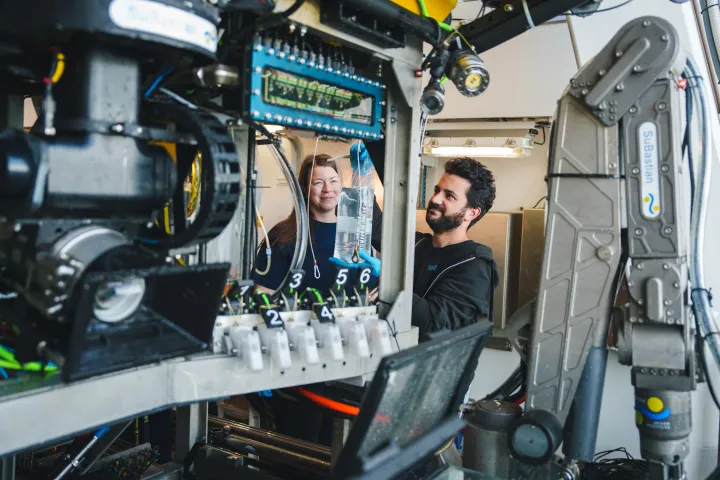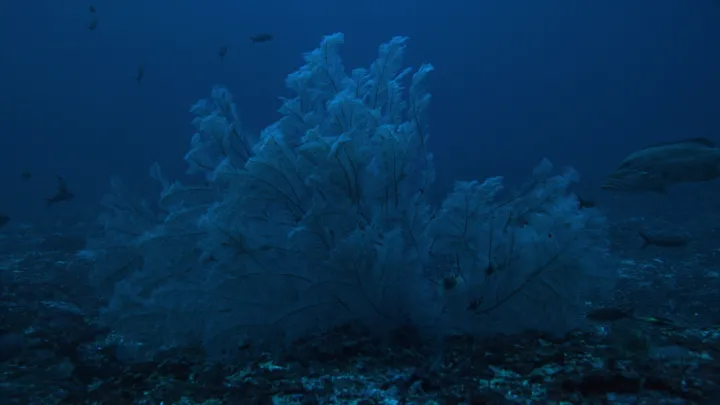Collecting Coral Codes: Environmental DNA Helps Scientists Assess Coral Biodiversity

When we picture corals, we often think of colorful bouquets in warm water, surrounded by swarms of tropical fish. But this image represents just a small snapshot of coral diversity. In fact, there are over 5,000 known coral species — including stony corals, black corals, and octocorals — many of which reside deep in the ocean and attached to the seabed.
Identifying the coral species in the deep sea can be a challenging task. In the past, scientists have relied on deep-water camera footage or physical specimens harvested from the ocean floor. But images can lead even coral experts to misidentify species that look similar to each other, and sampling requires physically removing a piece of the coral.
Now, scientists are harnessing the potential of another source of information: environmental DNA (shortened to eDNA). eDNA is the genetic material shed by organisms into their surroundings. Often, it comes in the form of dead tissue, mucus, or feces. Scientists can collect samples of the water in a location of interest and then take those samples to the lab to study the microscopic eDNA. The genetic information in the water samples allows scientists to identify the species present in that area.
A team of researchers at the Smithsonian’s National Museum of Natural History, Harvey Mudd College, and Lehigh University have been studying coral communities in the Gulf of Mexico using this eDNA technique. In a preprint paper available on bioRxiv, these researchers show a reliable way to assess coral diversity by comparing eDNA samples against known coral DNA sequences stored in a reference database.
According to Andrea Quattrini, a Smithsonian scientist on the team, measuring coral diversity is a great proxy for the health of the ecosystem.
“Biodiversity is critical for ecosystem functioning. We have limited opportunities to study biodiversity in the deep sea. But eDNA is a tool that can help us better characterize that biodiversity,” Quattrini explained.
To collect these eDNA samples from the ocean, Luke McCartin, a Ph.D. candidate and the paper’s first author, spends weeks at a time on the research vessel R/V Point Sur, sending remotely operated vehicles (ROVs) to collect water samples from various depths in the Gulf of Mexico.
Once the ROVs resurface with bottles of DNA-infused sea water, McCartin and his coworkers run the water samples through a filter and then freeze the filters containing the sampled DNA to take back to the lab. Then, in a molecular biology lab, McCartin and the rest of his team thaw the samples and extract the DNA.
The researchers amplified just a small section of this DNA known as a “DNA barcode” to identify the coral species. A DNA barcode functions much like the barcodes on grocery store items. At the grocery store, this means a quick scan of a sticker rather than an analysis of the whole item. For molecular biologists, it’s a matter of reading hundreds of base codes in a DNA barcode rather than the hundreds of millions of bases in the entire genome. And members of the same species (or same food item) should have the same barcode, while members of different species (or different food items) should have different barcodes.
Deciding which section of DNA should serve as the barcode is a challenge. McCartin describes the process as a “tradeoff,” where you risk identifying species that are not relevant and miss some you are trying to target. An effective barcode needs to be similar enough among species — or evolutionarily conserved — to let molecular tools recognize the sequence. But it also needs to include slight variations to differentiate between individual species, also known by scientists as evolutionarily divergent. This is similar to the “Happy Birthday” song, which always carries the same tune and words. The name will change depending on whose birthday it is, and help identify the recipient. The slight change is enough to differentiate between people, but not enough to make the song unrecognizable. Useful molecular bar codes should be the same.
The team discovered a suitable gene, called “28S rRNA,” which is present in high concentrations in the DNA of all coral species. The researchers then marked the beginning and end of the barcode so they could copy it and compare it to a database. According to the preprint paper, the majority of the resulting sequences were coral DNA — indicating that the chosen barcode works incredibly well to detect coral species in a water sample.
McCartin clearly remembers the first time he saw coral sequences in his data. “It just kind of blew my mind,” he recounted. “It was really like, oh my gosh, like there are coral sequences in here. This actually works!”
The 28S gene was also a good choice because of the large existing database of 28S coral DNA sequences. Scientists have already sequenced and recorded the 28S code for many coral species. But a big part of the research team’s work is to keep building on the reference database so that there’s something to compare the mystery barcode sequences against. When scientists compare a mystery DNA sequence to sequences in the database and there isn’t a match, there’s no way to know the identity of the coral.
“It’s kind of like searching for something on the internet that doesn’t exist yet,” Quattrini explained.
But when the reference sequence does exist in the database, it can make major discoveries possible. For instance, in an eDNA sample from the Gulf of Mexico, McCartin identified a coral group that was thought only to be present off the coast of South Africa. A later collection of the coral specimen itself confirmed the surprising finding of a new species and a new understanding of this group’s distribution.
Despite the fact that eDNA technology is still relatively new, eDNA measurements already have countless applications. They are already helping to characterize community changes in the Gulf of Mexico in the aftermath of the Deepwater Horizon oil spill. They will also be used to understand how heat waves — such as those off the coast of Florida in summer 2023 — can affect coral distribution.
At the Smithsonian NMNH, the value of eDNA shines through in the Ocean DNA initiative. This museum-wide effort aims to use DNA sequencing to survey marine life. By building up reference libraries — like the one these coral scientists have helped compile — the Ocean DNA initiative will help discover new species, detect invasive species, monitor ocean health, and inform conservation efforts.
According to Quattrini, scientists cannot even fully comprehend the bright future of eDNA research.
“We don’t really know all the questions we can ask right now,” Quattrini said. “But if we can preserve it, and if we can deposit it in a museum and have it publicly available to future generations, then who knows what kind of questions those scientists can ask in the future?”



